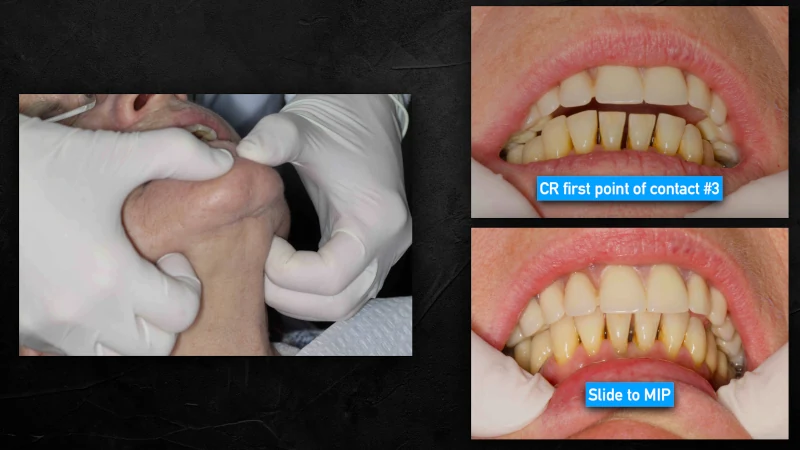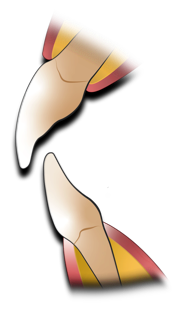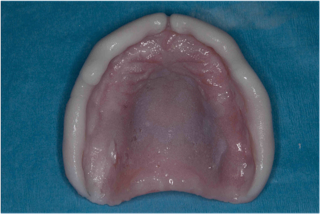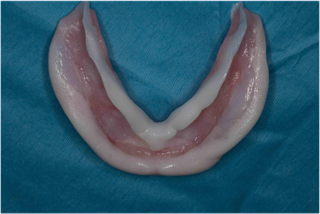- Office Hours Mon - Fri 9:00 am – 4:00 pm EST
There are three main areas that need attention when designing complete denture prostheses. When these three things are not accomplished, it can lead to misfits and patient dissatisfaction. I see it all the time.
 When we have centric prematurities on natural teeth, we may see signs of instability such as wear, mobility, recession, and abfraction. These signs of instability can occur when there is not harmony between the teeth and the joints. A centric prematurity on a complete denture, however, can result in looseness, dislodgment, and movement of the dentures causing sore spots. These complaints can often be mistaken for the need to reline the dentures. In my experience, it is almost always the occlusion that is the cause for these problems. It is critical that complete dentures be made in harmony with the joints.
When we have centric prematurities on natural teeth, we may see signs of instability such as wear, mobility, recession, and abfraction. These signs of instability can occur when there is not harmony between the teeth and the joints. A centric prematurity on a complete denture, however, can result in looseness, dislodgment, and movement of the dentures causing sore spots. These complaints can often be mistaken for the need to reline the dentures. In my experience, it is almost always the occlusion that is the cause for these problems. It is critical that complete dentures be made in harmony with the joints.
 There are two important things to note with regards to the position of the anterior teeth. The first factor is that denture occlusion requires the anterior teeth be OUT of contact in maximum intercuspation. We want only the posterior teeth to touch in a balanced occlusion. The reason for this is we want to protect the premaxilla from further resorption. It is important for dentures to be monitored over time because as the posterior teeth wear, the anterior teeth may come into contact. I have all of my denture patients on a yearly recall to do an oral cancer exam, check the occlusion, check for the need for relines, and evaluate the integrity of the denture teeth.
There are two important things to note with regards to the position of the anterior teeth. The first factor is that denture occlusion requires the anterior teeth be OUT of contact in maximum intercuspation. We want only the posterior teeth to touch in a balanced occlusion. The reason for this is we want to protect the premaxilla from further resorption. It is important for dentures to be monitored over time because as the posterior teeth wear, the anterior teeth may come into contact. I have all of my denture patients on a yearly recall to do an oral cancer exam, check the occlusion, check for the need for relines, and evaluate the integrity of the denture teeth.
The second factor relating to the anterior teeth is how they are set from a phonetic standpoint. We can make the prettiest, most perfect-fitting dentures but if we have a whistle, a lisp, or a slur, it’s an absolute failure. That all relates to the position of the anterior teeth and setting those teeth in a way where they can phonetically make those proper “S” sounds.
Problems can arisen when we do not properly account for border extension. The flanges of the denture are either:

 Obtaining proper impressions which capture the important anatomic landmarks for denture support, and custom border molding the impressions are things that we can do to ensure proper fit and extension. When we are finalizing the border extension at delivery, the use of Hydrocast can be critical to achieving perfect fit and comfort. Hydrocast is a functional impression material that enables the muscles to mold and shape the borders of the dentures as the patient is wearing them for a period of time. Once the patient is comfortable and accepts the fit of the dentures, the dentures are then hard relined. Accomplishing these 3 things will give you very happy patients!
Obtaining proper impressions which capture the important anatomic landmarks for denture support, and custom border molding the impressions are things that we can do to ensure proper fit and extension. When we are finalizing the border extension at delivery, the use of Hydrocast can be critical to achieving perfect fit and comfort. Hydrocast is a functional impression material that enables the muscles to mold and shape the borders of the dentures as the patient is wearing them for a period of time. Once the patient is comfortable and accepts the fit of the dentures, the dentures are then hard relined. Accomplishing these 3 things will give you very happy patients!
ADA CERP is a service of the American Dental Association to assist dental professionals in identifying quality providers of continuing dental education. ADA CERP does not approve or endorse individual courses or instructors, nor does it imply acceptance of credit hours by boards of dentistry.
Concerns or complaints about a CE provider may be directed to the provider or to the Commission for Continuing Education Provider Recognition at ADA.org/CERP.